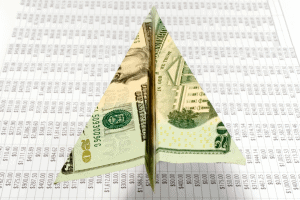Download the pdf copy here
Executive Summary
- Have you ever been involved in a slow moving discussion, debate, or difficult situation that you wish you could wake up and it would have ended? That is how we feel about the Federal Reserve’s battle to lower inflation and the nearly continuous conversation about whether the USA will fall into a recession. But until inflation is brought to heel, this preoccupation with it will not end.
- Interest rates and inflation remain the focus of all securities market participants.
- In their effort to contain inflation, the Federal Reserve increased the Federal Funds rate to 5.00 – 5.25% on May 4th. This represents an increase of 5% since the first increase on March 17, 2022. In addition, the Federal Reserve allows Treasuries and mortgage backed bonds it has purchased to mature without replacing them. This removes cash from its balance sheet, effectively eliminating the cash that it had created. Thereby reducing money supply. This is known as Quantitative Tightening (QT).
- Last quarter we pointed out that Federal Reserve monetary action has a delayed impact on the economy.
- In theory, with the increase of the Federal Funds rate to a range of 5% to 5.25%, the Federal Funds rate is in line with their preferred reading of inflation (PCE Core) at 4.6% (March reading) or 4.7% (April reading). This likely means that the Federal Reserve is nearing the end of their interest rate hiking cycle.
- Depending upon which measure of inflation one follows (CPI or PCE), inflation peaked between March and June in 2022. As with any economic reading, trends are never straight line, but inflation has been and continues to decline.
- Money supply (M2) is currency, bank deposits under $100,000, CDs, and money market mutual funds. It is fuel for our economy. Prior to the Covid pandemic, M2 was $15.32 Trillion at 2019 year end. Via QT, the Federal Reserve has lowered M2 eleven out of thirteen months and nine consecutive months through April this year (May data isn’t out yet). M2 at April month end was $20.67 Trillion. Long term Federal Reserve action to support stable economic growth targets M2 growth of 3% to 6% per year. At 6% growth from the end of 2019, M2 would be $18.6 Trillion. Fiscal and Monetary stimulus during the pandemic has resulted in excess M2 growth of over $2 Trillion even after a year of QT. This is very likely the source of resilience for the US economy.
- We would be remiss not to mention that the free capitalistic system has been functioning well in working to resolve the supply and demand imbalances that had led to this inflationary period.
Macro-Economic Perspective
- The USA has now strung together three quarters of real GDP growth. Q3 2022 was 3.2%. Q4 2022was 2.6%. Q1 2023 was 1.3%.
- Real GDP projections: Projections for real GDP growth in the USA seem to center on about 1.5% or 2023. Forecasters are in a very confusing time. Economists have rarely been so divided about the future aside from during a recession. We have seen consensus estimates of probability of a recession vary between 30% and 60% in a matter of a few months. The difficulty seems to lie in the plausibility of disparate outcomes from hard landing (recession) to soft landing (mild recession) and no landing (no recession). We are seeing organizations put out two forecasts, one with a recession and one without a recession. The difference in these dual forecasts is minimal. It is our opinion that we will either have a mild recession or avoid one altogether, but real GDP growth will be positive for the year.
- There is greater consensus on corporate earnings growth. Although an earnings recession doesn’t appear to be a certainty. Earnings growth for the S&P 500 companies was thought to be negative in Q4 2022 but with all companies reporting, earnings growth was 0.8%. Q1 2023 earnings growth for the S&P 500 so far is -0.7%. Economists have consistently estimated that earnings growth would be negative in Q1 and Q2 this year before turning flat in Q3 and then turning positive in Q4. Typically, the stock market anticipates outcomes six months down the road. If the corporate earnings growth expectations hold for the fourth quarter, one would expect positive return outcomes for the remainder of the year.
- Money Supply (M2 – cash, checking and savings deposits, money market mutual funds, and CDs). The Federal Reserve has been consistently lowering money supply month over month for the last nine months. We expect this effort to continue. But we estimate that money supply is $2 Trillion higher than it would have been had the pandemic stimulus not been put in place.
- The velocity of money (the frequency at which one unit of currency is used to purchase goods and services within a given period) is still historically very low.
- Inflation: Data suggests inflation has peaked, but its progression down is not a straight line.
- The Federal Reserve’s goal is to achieve a return to an inflation rate of 2%.
- Excluding shelter, food, and energy, (supercore) inflation rose 3.7% in April from the year earlier level.
- Inflation Expectations are coming down:
- The Fed’s median projection for Core PCE inflation for 2023 through 2025 is 3.6%, 2.6%, and 2.1%, respectively.
- Consumer expectations for inflation have a significant impact on its future course.
- In April, the New York Federal Reserve bank survey of consumer expectations for inflation in one year, three years, and five years were 4.4%, 2.9%, and 2.6%, respectively.
- In May, the bond market determined 5-Year and 10-Year Break-even Inflation rate was 2.22% for both.
- Consumer financial well-being is down a bit but seems to be stabilizing.
- The personal savings rate has declined from 8.8% in 2019 prior to the pandemic, after rising to double digit levels in 2020 and 2021, to below 3% for the last three months of 2022. The savings rate has rebounded to greater than 4% in March and April this year. In the aggregate, inflation has deteriorated consumers ability to save.
- Nominal M2 money supply remains supportive of consumer activity.
- Year over year real disposable income has risen every month this year. Nominal income increases peaked in March of 2022 at 5.9% and was 4.5% in April this year. (Bureau of Labor Statistics). These are good trends for the consumer and labor inflation.
- Real personal consumption expenditures, a comprehensive measure of consumer spending shows rising expenditures after adjusting for inflation throughout 2022 and continuing in Q1 2023.
- Household net worth reached $111.04T at the year-end 2019. Since then, it had risen 28% to $150T at the end of 2021. At Q3 2022 end, it declined to $135.3T. At 2022 yearend it was $139.9T. The 2021 year-end value looks like a near term peak, but household net worth continues to be supportive of economic growth. Source: Federal Reserve (March 2023 reading comes out in June).
- Bank of America Institute reports that savings and checking account balances remain substantially higher across income cohorts than they did before the pandemic. For households with annual income below $50,000, savings are still nearly 50% above the 2019 average.
- Bank delinquency rate ticked higher in 2022 from 0.5% to 0.56%. This is still below the prepandemic rate of 0.66%.
- Employment:
- There is some evidence of cooling, yet the unemployment rate is 3.4%. Job openings have declined from a peak of 12,000,000 in March of 2022 to 9,600,000 in March of 2023. This still accounts for a lot of unfilled jobs. The average level in 2017 through 2019 was 6.8 billion.
- The jobs gap (job openings plus overall employment less the number of people working or looking for work) has rarely been positive over the last two decades. But today there are about 4 million more jobs available than there are people unemployed.
- The labor-force participation rate has been rising steadily since November from 62.2% to 62.6% now.
- The labor department reports 4.3 million more jobs than a year ago.
- Goldman Sachs estimates that workers that have been laid off are being rehired by employers straining to find employees and that is contributing to the decline in openings. That helps keep wage growth in check while preventing the unemployment rate from going lower.
- Cautionary note: US companies with one to nine employees laid off over twice as many employees in March than they did in February.
- Bank failures:
- Although we anticipate tighter lending standards, the Federal Reserve’s Beige Book of anecdotal findings across regions of the USA reported very little “spillover” after the bank failures as of April 10th.
- Jaime Dimon, JPM Chase, “The banking crisis has provoked lots of jitters in the market and will clearly cause come tightening of financial conditions as banks and other lenders become more cautious, it is unclear if it will slow still-strong consumer spending”.
- Macro-economic Summary or Conclusions
- Real income has turned positive and real consumer spending is still rising.
- It is not clear that excess savings have been used up.
- The savings rate is less than half what it was before the pandemic, but it has ticked up 1% from last year end.
- Labor supply is still tight but is loosening. 4.3 million jobs have been added in the last year.
- Labor participation rate is rising.
- Wage growth is strong, but slowing, with hourly wages in lower-paying service jobs advancing more rapidly than the private-sector average.
- Huge progress has been made in goods inflation where most supply constraints have been resolved. Retailers report that their (downward) inventory adjustment effort is nearly complete. This will be a welcome change for shipping companies whose fortunes have gone from feast to famine.
- The Federal Reserve bank has been aggressive in their effort to reduce the money supply in 2022 and this year. Also, the Federal Funds rate went up 5% in one year. Interest rate increases may be nearing an end point, but more Quantitative Tightening will remain in place until a path to 2% inflation is visible.
- There is a case that the free capitalistic system and Fed tightening can combine to bring down inflation without killing the patient. We are cautiously optimistic.
Key Segments of the Economy
Consumer spending (70% of GDP): Month over month real personal consumption expenditures declined in November and December in 2022 and February this year. But year over year comparisons each month throughout 2022 and 2023 are positive. The Institute of Supply Management (ISM) reading for service rebounded to 55.2 in January 2023 and was 55.1, 51.2, and 51.9 in February through April. 50 is the dividing line between decline and growth.
Manufacturing (11% of GDP): The ISM reading for manufacturing dropped below 50 in November. It remained below 50 at 47.4, 47.7, 46.3, and 47.1 from January through April 2023. Industrial production recorded month-over-month declines in November and December and has been flat so far this year. This corresponds to the inventory reductions at retailers beginning last year.
Construction (4.1% of GDP): This data is not adjusted for inflation, but total $ spent on construction was down slightly from 2022 year end through March. Residential construction was down 9.8% year over year in March. Non-residential construction is running around 18% year over year gains each month this year through March. There isn’t any evidence of a slow-down in non-residential construction. But with a shortage of existing homes for sale, new residential housing starts may pick up. (Data from U.S. Census Bureau and Federal Reserve of St. Louis)
Home sales: The impact of high prices and higher interest rates are being felt in existing and new single-family home sales. The National Association of Realtors (NAR) reported that combined existing and new home sales declined 33% in 2022 from 6,929,000 to 4,636,000 units. Sales remain depressed in 2023. Mortgage data firm Black Knight reports that two-thirds of mortgages are under 4%. Further, 73% of
primary mortgages have a fixed rate for 30 years. At present mortgage rates, existing home sales will
remain depressed.
The supply of homes for sale has risen from 1.6 months in January 2022 to 2.6 months at the end of March this year. Six months’ supply is considered a balanced marketplace for buyers and sellers.
Housing affordability is a significant issue. Additional housing supply is needed, but higher interest rates will conflagrate the problem before it can get better. Median home prices fell every month from July 2022 through January 2023. Median prices dropped year over year in March and April this year. This will help to lower inflation, but with the short supply, we don’t expect this trend to continue. An eventual decline in interest rates would be most welcome, but this prospect is not yet on the radar.
Securities Market Perspective
By the end of the first quarter 2023, a 100% stock portfolio with 20% invested in international was up 6.70% with dividends reinvested. In another favorable reversal from last year’s decline, Intermediate term bonds (Bloomberg Aggregate Bond Index) and short-term bonds (Bloomberg U.S. Gov’t Credit 1 to 3 Year Bond Index) were up 2.96% and 1.51.%, respectively.
Prior to 2022, DBFM had moved a heavy portion of bonds into short term from intermediate term in anticipation of rising interest rates. We continued this process as rates increased last year. Longer term
bond prices are more negatively impacted by interest rate increases. The risk of pulling out of intermediate term high quality bonds (Bloomberg Intermediate Term Bond Index) is that these bonds would likely perform better should recession conditions become obvious as investors would move money into them for safe
keeping and in anticipation of a peak in interest rates. This action would drive the bond prices up / yields down. To account for the possibility of recession, the intermediate term bonds shifted to short term were invested in high quality. Although, we did keep allocations to satellite bonds (lower credit quality, alternatives, floating rate, and preferred stocks) unchanged. In retrospect, the heavy allocation to short term bonds significantly lowered the downside in the fixed income portion of portfolios in 2022.
Bond yields now appear much more attractive than they have been in over a decade, especially at the short end of the yield curve. However, with the FED intent on combating inflation via higher Federal Funds interest rates or holding them at this high level, we are not yet comfortable increasing duration of bond portfolios. As the Fed nears the point of no longer increasing the Federal Funds rate (which may be close at hand), we will need to shift more of the bond portfolios to intermediate term bonds. Meanwhile, the peak of the Treasury bond yield curve is at the short end.
At the end of the first quarter this year, as measured by price to book value, growth stocks were 95% above their long-term average of 4.83 at 9.42. This is a significant improvement from a peak level of 180% (2021 year-end) above the long-term average, but an increase from 77% at 2022 year-end (and still quite high). At the end of the first quarter this year, value stocks were 14.3% above their long-term average of 2.03 at 2.32, an improvement from a peak level of 23% (2021 year-end), largely unchanged from 2022 year-end.
After increasing use of quality growth mutual funds in 2020 to take advantage of the stay-at-home tech success, we eliminated mid-cap and small cap quality growth in 2021 and continued to reduce exposure to large cap quality growth funds throughout 2022. True to form we continue to favor value stocks. This enabled strong relative performance on the equity portion of portfolios in 2022. In 2023, growth stocks (led by a very small subset of stocks) have outperformed value stocks. This is a bit of a surprise given the presence of higher interest rates which lower the value of future earnings. But there may be a reaction to the large decline in growth stock prices in 2022, or a nod to their efforts to cut costs, or an avoidance of economically sensitive stocks (such as transportation, energy, and small cap stocks) over recession concerns. We are not yet certain/convinced that the deleterious link between higher interest rates and growth stocks has been broken.
As discussed at the top of page 2, corporate earnings growth stall or contraction in Q1 through Q3 this year is forecasted. Most analysts point to earnings growth returning in Q4. Despite recessionary concerns by some, equities seem poised for positive returns in 2023.
Wrap-Up
Black swans aside (debt bill or other), we see evidence of declining inflation and some cooling in the labor market, while the consumer and economy remain resilient. A recession remains a possibility, but we see it as a mild one if it were to occur.
In the meantime, we remain long term bullish, seeking necessary or opportunistic tactical adjustments to portfolios, and remain diversified for long term success.
Please feel free to contact us with any questions, or if you would like to schedule a face to face, virtual, or phone meeting.
Thank you,
Dave Dickmeyer, M.B.A
Wealth Advisor
Principal Owner
Ian D. Boyce, CFP®
Certified Financial Planner™
Principal Owner
Drew Lanphear, CFP®, RICP®
Certified Financial Planner™








